
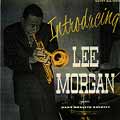
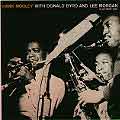

With a sound that belied that baby face and big ears (his classmates called him 'Howdy Doody') adorning so many Blue Note album covers, Lee Morgan was only 18 when he recorded his first leader sessions in 1956. From there he would go on to be present on some of the most epic sessions including Coltrane's Blue Train as well as his own Sidewinder.
Born July 10, 1938 in Philadelphia, Morgan took private lessons before studying at Mastbaum Tech. By 1953 he was rubbing shoulders with the big names such as Miles Davis and Clifford Brown at Philadelphia's Music City on Tuesday night jazz workshops. After a two week stint with Art Blakey's Jazz Messengers in the Summer of 1956 Morgan was invited to record his debut for Blue Note in November of that year, Lee Morgan Indeed! (BN 1538). A quick succession of recordings would ensue, including sessions with Hank Mobley on Savoy (the very next day in fact) as well as Blue Note's powerhouse blowing session, Hank Mobley with Donald Byrd and Lee Morgan (BN 1540) later in the month, and another leader session only a week later, The Lee Morgan Sextet (BN 1541). It should be noted that the above sessions for Blue Note were not in the least diminished by the ample ivory-work of Horace Silver.


 |
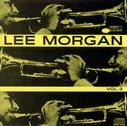 As if to compensate for a somewhat meteoric rise and acceptance in the hard bop fold, Lee Morgan signed on with the Dizzy Gillespie Orchestra right around the time of the above recordings, blending in with four other trumpeters inclucing the great Diz himself, and sharing the bandstand with such rising stars as tenor Benny Golson and pianist Wynton Kelly. The latter two would feature prominently on many of his future recordings such as his next leader session for Blue Note, Lee Morgan, Vol.3 (BN 1557), recorded on March 24, 1957. The session is especially memborable for Morgan's blowing on "I Remember Clifford", penned by Golson in memoriam to Clifford Brown who had been a great influence on Morgan and had died a year previous.
As if to compensate for a somewhat meteoric rise and acceptance in the hard bop fold, Lee Morgan signed on with the Dizzy Gillespie Orchestra right around the time of the above recordings, blending in with four other trumpeters inclucing the great Diz himself, and sharing the bandstand with such rising stars as tenor Benny Golson and pianist Wynton Kelly. The latter two would feature prominently on many of his future recordings such as his next leader session for Blue Note, Lee Morgan, Vol.3 (BN 1557), recorded on March 24, 1957. The session is especially memborable for Morgan's blowing on "I Remember Clifford", penned by Golson in memoriam to Clifford Brown who had been a great influence on Morgan and had died a year previous.
April 2, 1957--takes part in a lineup known as Art Blakey And The Jazz Messengers Plus Four. Fortunately this visit with the second version of the Jazz Messengers is recorded and now available as Theory of Art. Present are Bill Hardman (tp), Melba Liston (tb), Sahib Shihab (as), Johnny Griffin (ts), Cecil Payne (bs), Wynton Kelly (p), Jimmy DeBrest (b), and Art Blakey (ds - leader)
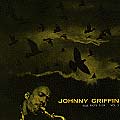 Still just 18 and holding orchestra duties with Gillespie's Orchestra, Morgan appeared on the historic Blue Note jam under Johnny Griffin's leadership, A Blowing Session (BN 1559), essentially a tenor battle between Griffin, Hank Mobley and John Coltrane. This session from April 6, 1957 would also include Art Blakey on drums, whose Jazz Messengers Morgan had "revisited" the previous week. Still just 18 and holding orchestra duties with Gillespie's Orchestra, Morgan appeared on the historic Blue Note jam under Johnny Griffin's leadership, A Blowing Session (BN 1559), essentially a tenor battle between Griffin, Hank Mobley and John Coltrane. This session from April 6, 1957 would also include Art Blakey on drums, whose Jazz Messengers Morgan had "revisited" the previous week.
|
A month later Morgan would make his compositional debut with the Clifford Jordan All Stars, contributing 'Ju-Ba' on Clifford Jordan (BN 1565). Ironically, Curtis Fuller (tro), who would rejoin him on his next leader session as well as on Blue Train, doesn't play on this one track.
On August 25, 1957 Morgan led a recording of Benny Golson arrangements entitled City Lights (BN 1575) in the company of Curtis Fuller (tb), George Coleman (ts/as), Ray Bryant (p), Paul Chambers (b), and Art Taylor (ds) The same day he recorded the first of two sessions that would become House Party (BN 4002) and The Sermon (BN 4002) with the Jimmy Smith All-Stars--Curtis Fuller (tb), George Coleman (as), Jimmy Smith (org - leader), Kenny Burrell or Eddie McFadden (g), Donald Bailey or Art Blakey (ds). Such double sessioning was not uncommon at the time, it being more convenient to produce a "quick" solo release utilizing a readily available rhythm section.
And for Morgan it certainly didn't detract from his performance as was evident by his September 15 itinerary when, following a session for the Ernie Henry All Stars (Last Chorus for the Riverside label) which included members of both Gillespie's Orchestra and Miles Davis' Quintet--Melba Liston (tb), Ernie Henry (as - leader), Benny Golson (ts), Cecil Paine (bs), Wynton Kelly (p), Paul Chambers (b), Philly Joe Jones (ds), he traveled to the Hackensack studio to record perhaps the greatest jazz session of all time, John Coltrane's Blue Train (BN 1577).

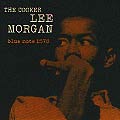 Two weeks later (September 29, 1957) Morgan still running high from Blue Train recorded the pivotal album, The Cooker (BN 1578), assisted by Pepper Adams (baritone sax) who would later feature prominantly in a Donald Byrd lineup, the soon-to-be-famous soul-swinging pianist, Bobby Timmons, later to pen the hit,"Dis Here", for Cannonball Adderley and "Moanin'" for Blakey's Jazz Messengers, along with Miles Davis rhythm strongmen Paul Chambers (b) and Philly Joe Jones (d). On this session Morgan not only provides a hot-iron version of the Gillespie classic, 'A Night In Tunisia', but contributes a couple of cookers of his own, 'Heavy Dipper' and 'New-Ma'.
Two weeks later (September 29, 1957) Morgan still running high from Blue Train recorded the pivotal album, The Cooker (BN 1578), assisted by Pepper Adams (baritone sax) who would later feature prominantly in a Donald Byrd lineup, the soon-to-be-famous soul-swinging pianist, Bobby Timmons, later to pen the hit,"Dis Here", for Cannonball Adderley and "Moanin'" for Blakey's Jazz Messengers, along with Miles Davis rhythm strongmen Paul Chambers (b) and Philly Joe Jones (d). On this session Morgan not only provides a hot-iron version of the Gillespie classic, 'A Night In Tunisia', but contributes a couple of cookers of his own, 'Heavy Dipper' and 'New-Ma'.

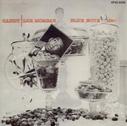 Lee Morgan's second of a classic pair, Candy (BN 1590) is a unique collection of standards and is the only solo album which features the young trumpeter in the context of a quartet. This album is also interesting in that it is comprised of two sessions (which took place November 11, 1957 and February 2, 1958 respectively) while maintaining both the same atmosphere and lineup--Sonny Clark (p), Doug Watkins (b), and drummer Art Taylor.
Lee Morgan's second of a classic pair, Candy (BN 1590) is a unique collection of standards and is the only solo album which features the young trumpeter in the context of a quartet. This album is also interesting in that it is comprised of two sessions (which took place November 11, 1957 and February 2, 1958 respectively) while maintaining both the same atmosphere and lineup--Sonny Clark (p), Doug Watkins (b), and drummer Art Taylor.
February 9, 1958--on Hank Mobley Quintet's Peckin' Time (BN 1574), along with Hank Mobley (ts - leader), Wynton Kelly (p), Paul Chambers (b), and Charlie Persip (ds).
February 25, 1958--reprises his role in the Jimmy Smith All Stars, again providing material for The Sermon (BN 4011) and House Party (BN 4002). Also present are Lou Donaldson (as), Tina Brooks (ts), Kenny Burrell (g), future employer Art Blakey (ds), and, Jimmy Smith (org - leader).
March 16, 1958--records the album Minor Moves with the Tina Brooks Quintet which goes unreleased by Blue Note until recently becoming available on a Brooks box set. Morgan contributes the tune, "Nutville". Also present are Tina Brooks (ts - leader), Sonny Clark (p), Doug Watkins (b), and Art Blakey (ds).
April 21, 1958--appears on Monday Night At Birdland along with friends Curtis Fuller (tb) and Hank Mobley (ts), as well as Billy Root (ts/bs), Ray Bryant (p), Tommy Bryant (b), and Specs Wright (ds). "Nutville" which finally finds release on this album for Roulette.
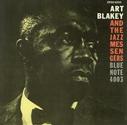 Having left the fold of the Dizzy Gillespie Orchestra, Lee Morgan, now 19, was looking for some new discipline in 1958. He soon found good company in perhaps the most remarkable lineups (this would be the third) the Jazz Messengers ever saw excepting the inaugural lineup of '55. Accompanied by old compatriot Benny Golson on tenor (later replaced by veteran Messenger Hank Mobley and later still, newcomer Wayne Shorter), Bobby Timmons on piano, Jymie Merritt (b), and of course, Art Blakey (d), Morgan would record a string of epic albums starting with Moanin' (BN 4003) from October 30, 1958. The album was a hit thanks to the Timmons title track.
Having left the fold of the Dizzy Gillespie Orchestra, Lee Morgan, now 19, was looking for some new discipline in 1958. He soon found good company in perhaps the most remarkable lineups (this would be the third) the Jazz Messengers ever saw excepting the inaugural lineup of '55. Accompanied by old compatriot Benny Golson on tenor (later replaced by veteran Messenger Hank Mobley and later still, newcomer Wayne Shorter), Bobby Timmons on piano, Jymie Merritt (b), and of course, Art Blakey (d), Morgan would record a string of epic albums starting with Moanin' (BN 4003) from October 30, 1958. The album was a hit thanks to the Timmons title track.
November 11, 1958--records with and on Benny Golson And The Philadelphians, along with Benny Golson (ts - leader), Ray Bryant (p), Percy Heath (b), and Philly Joe Jones (ds)
November 19, 1958--captured live in Holland with the above version of Art Blakey And The Jazz Messengers. Same lineup and similar tracks recorded for what would become 1958-Paris Olympia for the Fontana label on November 22 and December 17, 1958.
December 18 and 19, 1958--again for the Fontana label, Morgan along with the Jazz Messengers record the first of several French film soundtracks, Des Femmes Disparaissent, this one comprised mostly of very short incidental music.
December 21, 1958--still on tour in Europe, recorded at the Club St Germain with the Jazz Messengers. Kenny Clarke guests on the final two tracks.
March 16, 1959--One of the more interesting sessions is under the auspices of the Ahmed Abdul-Malik All Stars (bassist on the epic Monk/Coltrane Live at the Five Spot as well as "oudist" on Coltrane's Village Vanguard sessions) accompanied by the likes of Benny Golson and Johnny Griffin (ts), as well as various eastern musicians on violin, kanon and darabeka on the hard-to-find East Meets West.
April 15, 1959--Mobley having replaced Benny Golson on tenor, Art Blakey And The Jazz Messengers record At The Jazz Corner Of The World Vol.1 and 2 (BN 4015 and 4016) at Birdland.
May 4 and 11, 1959--Guests on Drums Around the World with the Philly Joe Jones Big Band--Blue Mitchell (tp), Curtis Fuller (tb), Herbie Mann (fl/piccolo), Cannonball Adderley (as), Benny Golson (ts), Sahib Shihab (bs), Wynton Kelly (p), Sam Jones or Jimmy Garrison (b), Philly Joe Jones (ds - leader) for the Riverside.
May 14, 1959--part of fellow trumpeter Art Farmer's Tentet on Brass Shout, a collection of Benny Golson arrangements with Art Farmer (tp - leader), Ernie Royal (tp), Jimmy Cleveland, Curtis Fuller, Wayne Andre (tb), James Haughton (bari. sax), Julius Watkins (fhr), Don Butterfield (tuba), Percy Heath (b), Philly Joe Jones or Elvin Jones (ds). The next day, the session is continued without Jimmy Cleveland and Elvin Jones, but with Bobby Timmons (p), and Bob Norther replacing Julius Watkins.
July 4, 1959--Jazz Messengers play at the Newport Jazz Festival.
July 28 and 29, 1959--Art Blakey and the Jazz Messengers record music for the French film, Les Liaisons Dangereuses, little of which is actually heard in the movie despite its brilliance. Instead music by Thelonious Monk dominates the movie. Present for this eclectic and wonderful session are Frenchman Barney Wilen (ts/ss), Bobby Timmons or Duke Jordan (p), Jymie Merritt (b), Art Blakey (ds - leader), John Rodriguez (bgo), Tommy Lopez, Willie Rodriguez (conga). Interestinly, Duke Jordan, trumpeter Kenny Dorham and drummer Kenny Clarke appear in the movie, and do an especially poor job "air-jamming" to the Jazz Messengers.
August 12, 1959--on the Wynton Kelly Quintet album, Kelly Great along with Wayne Shorter (ts), Wynton Kelly (p - leader), Paul Chambers (b), Philly Joe Jones. Morgan contributes "What Now".
August 25, 1959--on The Curtis Fuller Jazztet With Benny Golson: Curtis Fuller (tb), Benny Golson (ts), Wynton Kelly (p), Paul Chambers (b), and Charlie Persip (ds).
November 5, 1959--recorded while on a European tour with the Jazz Messengers again--now with Wayne Shorter (ts) and Walter Davis Jr. Live In Copenhagen 1959.
November 10, 1959--on Africaine with Art Blakey And The Jazz Messengers. Interestinly, the Jamaican trumpeter, Dizzy Reece, appears on a couple of the tracks--but on conga! Morgan contributes "The Midget".
November 10, 1959--on fellow Jazz Messenger Wayne Shorter's debut leader session, Introducing Wayne Shorter along with the Miles Davis rhythm secion of Wynton Kelly (p), Paul Chambers (b), and Jimmy Cobb (ds).
November 15, 1959--recorded at the Theatre Des Champs-Elysees, in Paris, France with Art Blakey And The Jazz Messengers
Lee Morgan (tp), Wayne Shorter (ts), Walter Davis Jr. (p), Jymie Merritt (b), Art Blakey (ds), "Theatre Des Champs-Elysees", Paris.
November 23, 1959--live at Konserthuset in Stockholm, Sweden with Art Blakey And The Jazz Messengers.
November 29, 1959--live at Titania-Palast in West Berlin, Germany with Art Blakey And The Jazz Messengers.
December 4, 5 and 9, 1959--back in New York, appears on one of Quincy Jones' massive all-start sessions along with Ernie Royal, Lennie Johnson, Nick Travis, Art Farmer, Jimmy Maxwell (tp), Julius Watkins (frh), Urbie Green, Frank Rehak, Billy Byers, Jimmy Cleveland (tb), Phil Woods, Porter Kilbert, Jerome Richardson, Budd Johnson, Sahib Shihab (sax), Patti Bown (p), Les Spann (g), Buddie Jone (b), Don Lamond (ds), Quincy Jones (arr/cond - leader)--released on Mercury Records as The Great Wide World Of Quincy Jones.
December 18, 1959--back in Europe with Art Blakey And The Jazz Messengers. Paris Jam Session on Fontana captures the band at their best, and with the bonus of pianist Bud Powell replacing Davis on Powell's "Dance of the Infidels" and "Bouncing with Bud".
March 9, 1959--along with Curtis Fuller (tb - leader), Hank Mobley (ts), Tommy Flanagan (p), Paul Chambers (b), and Elvin Jones (ds) on Curtis Fuller Sextet's Sliding Easy, a collection of Benny Golson and Gigi Gryce arrangements available on United Artists.

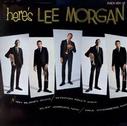 After nearly two years of dedicated studio and touring obligations with Art Blakey's Jazz Messengers as well as the numerous guest appearances listed above, Morgan finally found the time to resume his leader sessions. Here's Lee Morgan marks the first of several albums he did for the Vee-Jay label. Recorded February 3, 1960, Morgan is joined by Clifford Jordan (ts), Wynton Kelly (p), Paul Chambers (b) and employer Art Blakey (ds). Morgan penned the titles "Bess", "Mogie", and "Terrible 'T'". The CD reissue adds five alternate takes bringing it to over 70 minutes of fine hard bop.
After nearly two years of dedicated studio and touring obligations with Art Blakey's Jazz Messengers as well as the numerous guest appearances listed above, Morgan finally found the time to resume his leader sessions. Here's Lee Morgan marks the first of several albums he did for the Vee-Jay label. Recorded February 3, 1960, Morgan is joined by Clifford Jordan (ts), Wynton Kelly (p), Paul Chambers (b) and employer Art Blakey (ds). Morgan penned the titles "Bess", "Mogie", and "Terrible 'T'". The CD reissue adds five alternate takes bringing it to over 70 minutes of fine hard bop.
March 6, 1960--on The Big Beat with Art Blakey And The Jazz Messengers.
April 16 and 23, 1960--with Art Blakey And The Jazz Messengers and joined by drummer Buddy Rich at Birdland.
April 25, 1960--amongst the Young Lions along with Frank Strozier (as), Wayne Shorter (ts), Bobby Timmons (p), Bob Cranshaw (b), Louis Hayes, Al Heath (ds) recorded for Vee-Jay. Morgan contributes the piece, "That's Right".

 Back in the studio for Blue Note, Morgan joined up with Jackie McLean (as), Bobby Timmons (p), Paul Chambers (b), and Art Blakey (ds) to record the album Lee Way (BN 4034), on April 28, 1960. Morgan only pens one track, "The Lion and The Wolff", a tribute to Blue Note producer Alfred Lion and photographer, Francis Wolff. Despite being a strong session, this remains one of Morgan's more obscure sessions. McLean makes his presence felt on his contribution, "Midtown Blues".
Back in the studio for Blue Note, Morgan joined up with Jackie McLean (as), Bobby Timmons (p), Paul Chambers (b), and Art Blakey (ds) to record the album Lee Way (BN 4034), on April 28, 1960. Morgan only pens one track, "The Lion and The Wolff", a tribute to Blue Note producer Alfred Lion and photographer, Francis Wolff. Despite being a strong session, this remains one of Morgan's more obscure sessions. McLean makes his presence felt on his contribution, "Midtown Blues".
May 28 and June 4, 1960--another live session at Birdland with Art Blakey And The Jazz Messengers.
June 7, 1960--on Curtis Fuller's Images for the Savoy label along with Curtis Fuller (tb - leader), Yusef Lateef (ts), McCoy Tyner (p), Milt Hinton (b) and Bobby Donaldson (ds).
August 7 and 14, 1960--back in the studio is Art Blakey And The Jazz Messengers on tracks that will eventually become Like Someone In Love (BN 4245) and A Night In Tunisia (BN 4049). Contributes the tracks "Yama" "Kozo's Waltz", and "Johnny's Blues".
September 11 and 14, 1960--live at Birdland with Art Blakey And The Jazz Messengers.

 A change of venue to Chicago, a strange title, and Morgan really clears the deck with this one for Vee-Jay recorded on October 13, 1960. Joined by Clifford Jordan (ts), Ed Higgins (p), Art Davis (b), and Art Blakey (ds), the album virtually explodes on the title track penned by Higgins, as well as Wayne Shorter's "Fire". The CD reissue comes with alternate takes of several of the tracks including Morgan's "Triple Track". Highly recommended set.
A change of venue to Chicago, a strange title, and Morgan really clears the deck with this one for Vee-Jay recorded on October 13, 1960. Joined by Clifford Jordan (ts), Ed Higgins (p), Art Davis (b), and Art Blakey (ds), the album virtually explodes on the title track penned by Higgins, as well as Wayne Shorter's "Fire". The CD reissue comes with alternate takes of several of the tracks including Morgan's "Triple Track". Highly recommended set.
December 6, 1960--with Art Blakey And The Jazz Messengers live in Stockholm, Sweden.
December 8, 1960--live at the Theatre de Beaulieu Lausanne, Switzerland with Art Blakey And The Jazz Messengers, released as Art Blakey And The Jazz Messengers Lausanne 1960, Part I. Amongst the tracks is Morgan's "Kozo's Waltz".
January 2, 1961--with Art Blakey And The Jazz Messengers at Sankei Hall, Tokyo, Japan.
February 12, 1961--contributes "Pisces" to a short session with Art Blakey And The Jazz Messengers. The four tracks would be added to the CD reissue of The Freedom Rider (BN 4156)
February 18, 1961--contributes "Petty Larceny", which will appear on The Freedom Rider (BN 4156), to a session dominated by Wayne Shorter compositions. The rest of the session will find release only later on Roots And Herbs (BN 4347).
March 14, 1961--with Art Blakey And The Jazz Messengers contributes "Afrique" along with two versions of the title track to the album, The Witch Doctor (BN 4258).
May 6, 1961--in Manchester, England while on tour again with Art Blakey And The Jazz Messengers.
May 13, 1961--return to Olympia, Paris with Art Blakey And The Jazz Messengers.
May 27, 1961--back in New Jersey, session Art Blakey And The Jazz Messengers that will provide the final tracks for The Freedom Rider (BN 4156), two of which are Morgan compositions: "Uptight" and the contemplative masterpiece, "Blue Lace".
June 13 and 14, 1961--sessions with Art Blakey And The Jazz Messengers that will become the album A La Mode for the Impulse label. Curtis Fuller (tb) is now in the group. Morgan is no longer an official member, having been replaced by the up-and-coming trumpet sensation, Freddie Hubbard.
September 21, 1961--drops by for one track on Wynton Kelly's Someday My Prince Will Come along with Wayne Shorter.
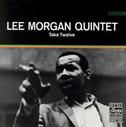 The next couple of years would be relatively dry for Morgan, with only a smattering of leader sessions to indicate his activities. The first of these, from January 24, 1962 found Morgan with a slew of fresh compositions and a lineup consisting of Clifford Jordan (ts), Barry Harris (p), Bob Cranshaw (b) and Louis Hayes (ds). The Jazzland CD resissue of the Lee Morgan Quintet's Take Twelve includes Morgan originals "Raggedy Ann", "A Waltz For Fran", "Lee-Sure Time", and "Second's Best".
The next couple of years would be relatively dry for Morgan, with only a smattering of leader sessions to indicate his activities. The first of these, from January 24, 1962 found Morgan with a slew of fresh compositions and a lineup consisting of Clifford Jordan (ts), Barry Harris (p), Bob Cranshaw (b) and Louis Hayes (ds). The Jazzland CD resissue of the Lee Morgan Quintet's Take Twelve includes Morgan originals "Raggedy Ann", "A Waltz For Fran", "Lee-Sure Time", and "Second's Best".
Nearly a year would elapse before the November 17, 1962 session with Jimmy Heath (ts), Barry Harris (p), Spansky DeBrest (b) and Al Heath (ds). The three tracks, none of which are Morgan's would be issued on a compilation with Oscar Peterson and Jimmy Heath sessions. A mediocre session at best, Morgan's horn would be silent for nearly a year.
October 2, 1963--on the session with the Hank Mobley Quintet, Morgan blasts back in peek form after a hiatus of over two year. No Room For Squares finds him in the company of one of Blue Note's more interesting lineups and fantastic results with Hank Mobley (ts - leader), the fringe avant garde pianist, Andrew Hill, John Ore (b) and Philly Joe Jones (ds). Morgan augments the collection of Mobley originals with the sweet tune, "Carolyn" and "Me 'n You".
November 21, 1963--delving into the avant garde with Jackie McLean's resident trombonist, Gracham Moncur III on Blue Note's eclectic session, Evolution (BN 4153), which includes Grachan Moncur III (tb - leader), Jackie McLean (as), Bobby Hutcherson (vib), Bob Cranshaw (b) and Tony Williams (ds).